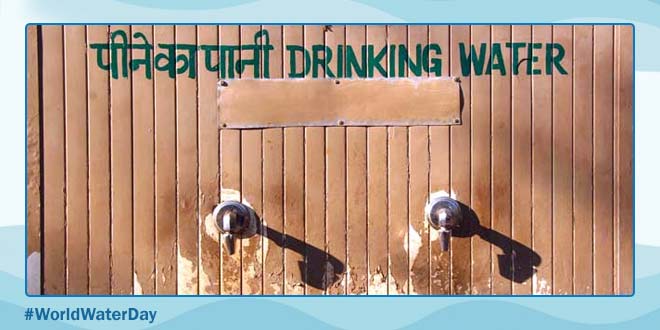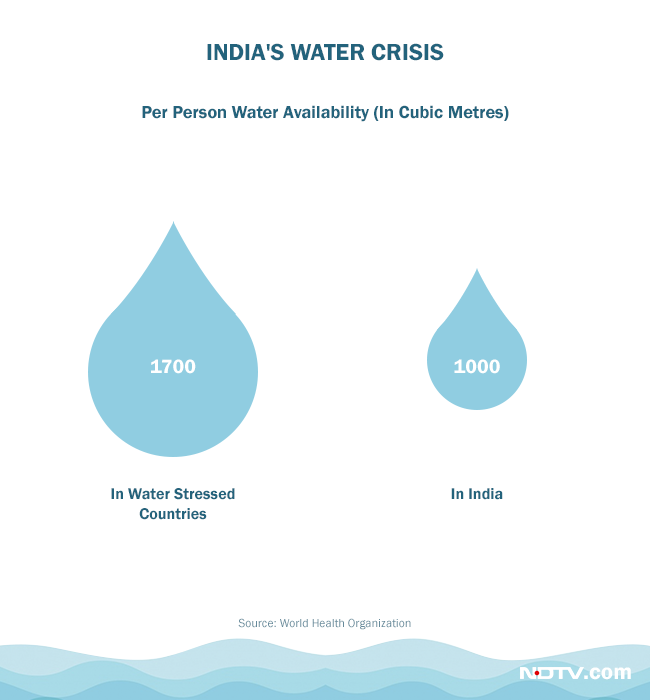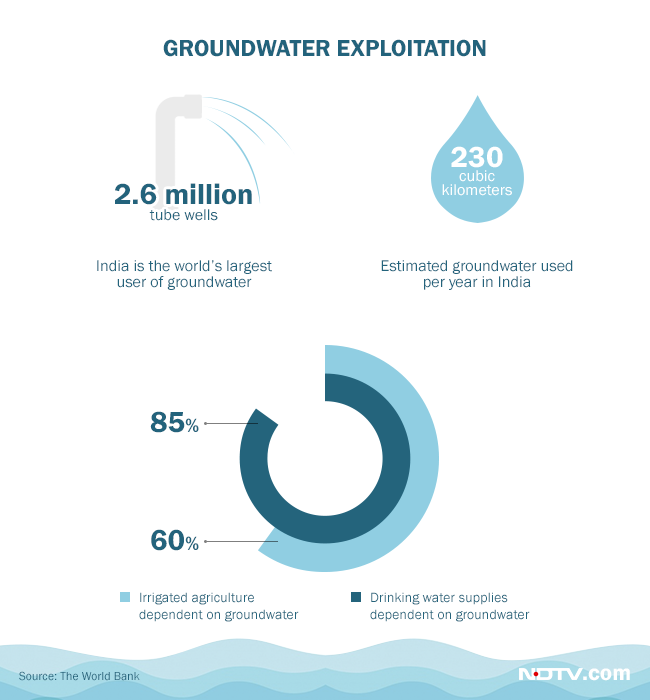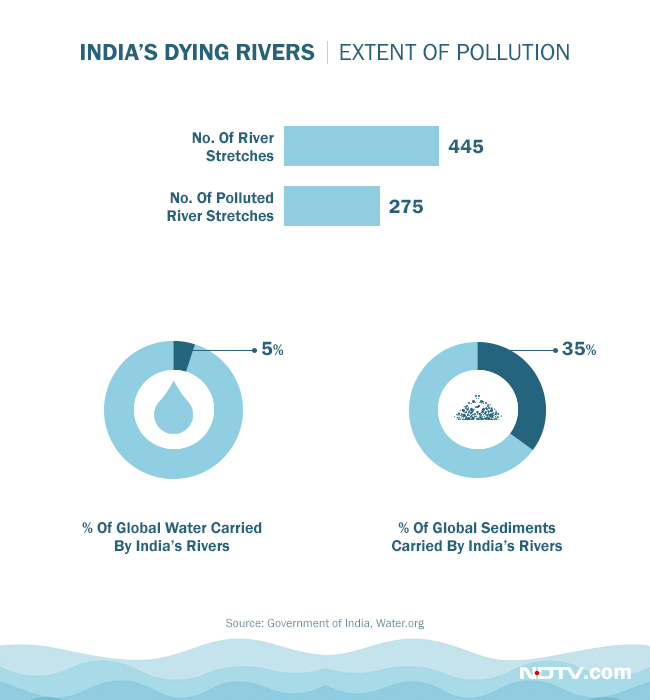Highlights
- India is looking at a looming water crisis due to mismanagement of water
- India will have a water deficit of 50% by 2030: Asian Development Bank
- Water scarcity can hit India's economic growth by 6%, Says World Bank
New Delhi: India faces a turbulent water future, thanks to a combination of growing population, industrial units, rapid growth in urban areas, and the current water development (making an area of water more useful) and management system which is not sustainable, warned the World Bank report ‘India’s Water Economy, Bracing for a Turbulent Future’ published in 2006. According to the report, unless water management practices are changed – and changed soon – India will face a severe water crisis within the next two decades and will have neither the cash to build new infrastructure nor the water needed to sustain its growing economy and rising population. As per a forecast done by the Asian Development Bank, India will have a water deficit of 50 percent by 2030 as the demand is growing and supply is constant. Even the Union Ministry of Water Resources has estimated that India’s water requirement which is 1100 billion cubic meters per year (2017) will grow to around 1200 billion cubic metres for the year 2025 and 1447 billion cubic metres in 2050. With India’s projected population growth of 1.7 billion people by 2050, the available water resources (estimated to be between 700 to 1,200 billion cubic meters as per National Bureau of Asian Research) would barely match the total water requirement. The numbers are scary, and the bottom line is that, we are looking at a looming water crisis, which the Union Minister for Water Resources, Nitin Gadkari also agrees to. Speaking at Nadi Mahotsav (River Festival) last week, he said, “India’s water problem stems from mismanagement of water. We have to adopt a scientific approach in the planning and conservation of water in order to ensure a balance.”
Government data reveals that water scarcity is fast becoming urban India’s number one woe as 22 out of 32 major cities have to deal with daily shortages due to mismanagement of water resources. India loses precious water due to dilapidated water infrastructure and pipe leakages.
According to data available on Indiawatertool.in, a web platform that evaluates India’s water risks, around 54 percent of India’s total area faces high to extremely high water stress, which means about 600 million people are at higher risk of disruptions in water supply due to shortage of water.
Notably, the extremely high stress areas are in Northwest India, which is the country’s breadbasket. The states of Punjab and Haryana alone produce 50 percent of the national government’s rice supply and 85 percent of its wheat stocks, and both the crops are highly water intensive.
Also Read: 5 Major Things India Can Learn From The Global Water Crisis
India is not a water scarce country. Along with having major rivers, we receive an average annual rainfall of 1170 millimeters. But lack of sensitisation with regard to both conservation of water and pollution of water sources has resulted in a large part of the population for whom water has become more of a curse than a boon. Infrastructure for storage of water must be developed properly to ensure that people have access to safe water across the country, said Dr. Narayan G. Hegde, Author of the ‘Water Scarcity in India’ report done by BAIF Development Research Foundation, Pune, while speaking to NDTV.
What are the major water development and management challenges that India is facing?
1). Groundwater exploitation: India is the world’s largest user of groundwater according to THE World Bank. Faced with poor water supply services, farmers and urban dwellers alike have resorted to helping themselves by pumping out groundwater through tube wells. Through the construction of 2.6 million tube wells (according to the fifth minor irrigation Census carried out by the Union Water Resources Ministry), there has been a phenomenal growth in the exploitation of groundwater in the last five decades. India uses an estimated 230 cubic kilometers of groundwater per year as over 60 percent of irrigated agriculture and 85 percent of drinking water supplies are dependent on this.
Despite the valuable nature of the resource, 29 percent of groundwater blocks are semi-critical, critical, or overexploited, and the situation is deteriorating rapidly. For the six states (Gujarat, Haryana, Maharashtra, Punjab, Rajasthan, and Tamil Nadu) taken together, 54 percent of the groundwater blocks fall in the semi-critical, critical, or over-exploited categories.
And if the current trends continue, by 2030 about 60 percent of all India’s aquifers (water-bearing rock that transmits water to wells and springs) will be in a critical condition, and it will have serious implications for the sustainability of agriculture, long-term food security, livelihoods, and economic growth.
Also Read: Why A Water Surplus Hyderabad Faces Dry Spells In Summers
According to another World Bank study (High and Dry: Climate Change, Water, and the Economy), water scarcity will jeopardise growth prospects in India, and if it continues to mismanage water resources, it stands to lose 6 percent of its Gross Domestic Product (GDP) by 2050. On the contrary, if India efficiently manages it water resources, it can actually add 1 percent to its GDP.
If countries do not take action to better manage water resources, our analysis shows that some regions with large populations could be living with long periods of negative economic growth. But countries can enact policies now that will help them manage water sustainably for the years ahead, suggested World Bank President Jim Yong Kim.
2). Inefficient rainwater harvesting: In terms of rainwater harvesting, one of the most effective methods of water management and water conservation for irrigation purposes, to recharge aquifers, to ensure water availability in water-scarce zones and for other purposes, India lags way behind the developed countries. As per World Bank findings, India with its current infrastructure can store only about 30 days of rainfall, compared to 900 days in major river basins in arid areas of developed countries.
In 2015, the Ministry of Water Resources, River Development and Ganga Rejuvenation stated that though India receives an average annual rainfall of 1170 mm, poor storage infrastructure allows it to store only 6 percent of rainwater, compared to 250 percent stored by developed nations.
Rainwater storage and harvesting is not a regular practice in India and people are not even aware about its benefits. According to A R Shivakumar, Senior Scientist at the Karnataka State Council of Science and Technology (KSCST) at Indian Institute of Science (IISc), if water-starved Bengaluru, which is among the 10 cities in the world that might be on the verge of an acute water crisis according to Centre for Science and Environment’s ‘Down To Earth’ magazine, manages to recharge even 30 percent of the rainwater it gets, it will have more than what the Cauvery River is supplying currently to the city. Imagine what India could achieve if people start harvesting the rainwater.”
3). India’s thermal power plants in water-scarce areas: According to a new report ‘Parched Power Water Demands, Risks, and Opportunities for India’s Power Sector’ by World Resources Institute, a research organisation, 40 percent of the India’s thermal power plants are located in areas facing high water stress, a problem since these plants use fresh water for cooling. “We found that almost 90 percent of India’s thermal power generation depends on freshwater for cooling, and the industry is only growing thirstier. As per the estimates, 70 percent of India’s thermal power plants will face high water stress by 2030,” said the report.
The freshwater consumption from Indian thermal utilities grew by 43 percent from 2011-2016, from 1.5 to 2.1 billion cubic meters a year. To put this in perspective, India’s total domestic water consumption in 2010 was about 7.5 billion cubic meters, according to the Aqueduct Global Water Risk Atlas. That means power plants drank about 20 percent as much water as India’s 1.3 billion citizens use for washing dishes, bathing, drinking and more, highlighted the report.
The report recommended that thermal utilities should upgrade cooling systems, improves plant efficiency, and should ultimately shift toward water-free renewables like solar photovoltaics and wind to curb water risks to power generation. However, it’s worth noting that the government of India already has plans in place that give reason for hope, such as the notification on power plant water withdrawal limits that asks for controlled usage of water. If these policies are enacted and enforced, the estimates by World Resources Institute show that India will save 12.4 billion cubic meters of freshwater from being withdrawn by power plants.
A recent Greenpeace report found that in Maharashtra’s drought-hit regions, each year they use water equivalent to a basic minimum supply to 1.2 crore persons – even when most of the plants follow the best water-saving technology. Greenpeace also found out that almost half the reserves of coal – which fuel the thermal plants – fall in areas where mining can threaten freshwater sources, besides causing deforestation.
4). Polluted Rivers: Water supply in India has two principal sources, namely from groundwater and water from rivers, which are shrinking because of pollution and industrialisation, while the population keeps growing, pushing us towards an enormous water deficit. According to a World Bank report, the dumping of sewage and waste water from rapidly growing cities have led to large sections of important rivers like Ganga and Yamuna becoming unfit for use. Take for instance, the Ganga, one of the world’s most polluted rivers, which flows through 11 states of India and provides water to more than 500 million people.
Also Read: Surface And Groundwater Pollution Are Pushing India Towards A Water Crisis
Many parts of the Ganga in Bihar and Uttar Pradesh have become completely unfit for use because of incessant waste disposal, ranging from dead bodies and to industrial waste. Earlier the water in many parts of these two states could be consumed and used for other purposes, but pollution has rendered the river water completely useless, said Vikas Chandra, an activist who has been campaigning for a pollution free Ganga for the last 19 years.
Several initiatives have been undertaken to deal with the water crisis looming ahead of India, both by government and non-government bodies. In 2014, the 20,000 crore Namami Gange program was announced by the Union Government. It is a holistic program that focuses on cleaning the Ganga, along with setting up biodiversity centers, crematoriums and toilets along the river banks to reduce pollution in the river.
Also Read: Dams In India Did More Harm Than Good, Says UN Water Report
Taking a cue from the looming water crisis, the government is now laying more emphasis on conserving water. In February 2018, Union Minister for River Development, Water Resources and Surface Transport, Nitin Gadkari said that a new project ‘Atal Bhujal Yojana’ is being implemented across the country at a cost of Rs. 6,000 crore. Under the project, programmes such as the construction of check-dams would be taken up across the country to conserve water. Stating that linking of rivers was one of the major projects and aims of his Ministry, he said that in the first phase, the rivers of central and south India would be linked for using a huge quantum of water that is currently getting wasted by flowing into the sea.
Every year, more than 3,000 thousand million cubic feet of water goes into ocean. By linking rivers, we could save this water to help states such as Gujarat, Rajasthan, Madhya Pradesh, Chhattisgarh, Karnataka, Andhra Pradesh, Tamil Nadu and Telangana, the minister further said.
Talking about how India can curb the water crisis, Dr Suresh Kumar Rohilla, Programme Director, Water Management, Centre for Science and Environment (CSE) said, “India should make provisions for water sanctuaries for conservation of the precious resource in its rapidly growing cities.”
Also Read: United Nations Urges Everyone To Realise The Importance Of Water Management
Importantly, India should not take the resource as valuable as water for granted – it is a diminishing resource. India cannot have a secure water future unless there are drastic changes in the way we all manage our water resources. The government should launch campaigns to encourage water conservation and educate people on how to conserve water and reduce wastage. In addition to this, past attention to infrastructure development has to be complemented with present attention to water resource and infrastructure management. And, policies and practices have to come to grips with the challenges of the future, recommends the World Bank.































